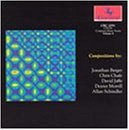| All Artists: Cdcm Computer Music Series Title: CDCM Computer Music Series, Vol. 8 - CCRMA, Stanford University Members Wishing: 1 Total Copies: 0 Label: Centaur Release Date: 11/9/1993 Genres: Special Interest, Classical Style: Chamber Music Number of Discs: 1 SwapaCD Credits: 1 UPC: 750582970535 |
Search - Cdcm Computer Music Series :: CDCM Computer Music Series, Vol. 8 - CCRMA, Stanford University
 | Cdcm Computer Music Series CDCM Computer Music Series, Vol. 8 - CCRMA, Stanford University Genres: Special Interest, Classical
|
Larger Image |
CD Details |
CD ReviewsPutting a human - if rather stern - face on computer music Steve Benner | Lancaster, UK | 10/16/2001 (4 out of 5 stars) "This eighth release from the Consortium to Distribute Computer Music (CDCM) focuses on works for live performers, with loudspeaker additions. In all cases, the performers here are members of the Jefferson String Quartet, augmented by pianist Nohema Fernandez and soprano Pamela Jordan. All of the works on the disc are from the pen (computer keyboard?) of composers based at the Center for Computer Research in Music and Acoustics (CCRMA) at Stanford University, CA.Chris Chafe's opening work, "Quadro" (1987) for piano trio and tape, draws its title from the name of a constructional toy, because, says the composer in his sleeve notes, `the music is continually rebuilt on various time scales with different sonic material.' The piece consists primarily of long pedal tones and dense textures, arising from a tightly integrated score for the live musicians and a concentrated tape part which frequently fills any would be gaps in the live playing. The result is a work of great intensity, generating an overbearingly dark and brooding atmosphere throughout its 14 minutes.Only marginally lighter (and shorter) is "Tremor of Night and Day" (1984) for cello and tape, by Allan Schindler. The work is a reflective study in texture and changing light, with a mostly lyrical and flowing line for the soloist, set against a gentle computer-generated accompaniment of synthetic sounds and ghostly, processed whispering.While quite short, at just under 6 minutes, David Jaffe's "Telegram to the President" (1985) is another work of some intensity, at least in part, with a busy tape component, which runs rings around the playing of a live string quartet. Inspired by the composer's bitter disappointment at the re-election of Ronald Reagan as US President in 1984, the work carries a strong tone of indictment, although with a rather quirky underlying message of hope. It is fun in parts but ultimately rather disconcerting.Hope is not something that features much in Jonathan Berger's settings of poems on the atrocities of war, "Diptych" (1986) for string quartet, soprano and tape. Pamela Jordan performs these rather chilling songs (in English and Spanish) against a background of angrily buzzing string textures and digitally processed foetal heartbeats. Disturbing stuff indeed!The disc's mood is eventually lightened by its final work, Dexter Morrill's 15-minute composition, "Quartet" (1985), written for the unusual combination of violin, cello and two loudspeakers. A tape part consisting of digitally generated and processed samples feeds the two loudspeakers, which are intended to replace the missing two members of the conventional string quartet. The work is in three movements. The first, `Proportions', has the live players as well as the tape part, exploring various complex subdivisions of the beat. The short second movement, `Solo', is given over to tape alone, played back through a single loudspeaker, while the third, `Polytime', pairs each performer with one of the loudspeakers and has them engage in several exchanges in conflicting tempi. The work is no less intense than the rest of the disc, although it is far less demanding on the listener. Its precisely constructed finale brings the disc to a satisfying conclusion.In summary, I would say that this disc deserves to be on the shelves of anyone seriously interested in late twentieth century chamber music. There is absolutely no need to let the `computer music' label put you off, provided your mind and ears are open to an extension of the range of sonorities usually associated with the string quartet."
|

 Track Listings (5) - Disc #1
Track Listings (5) - Disc #1